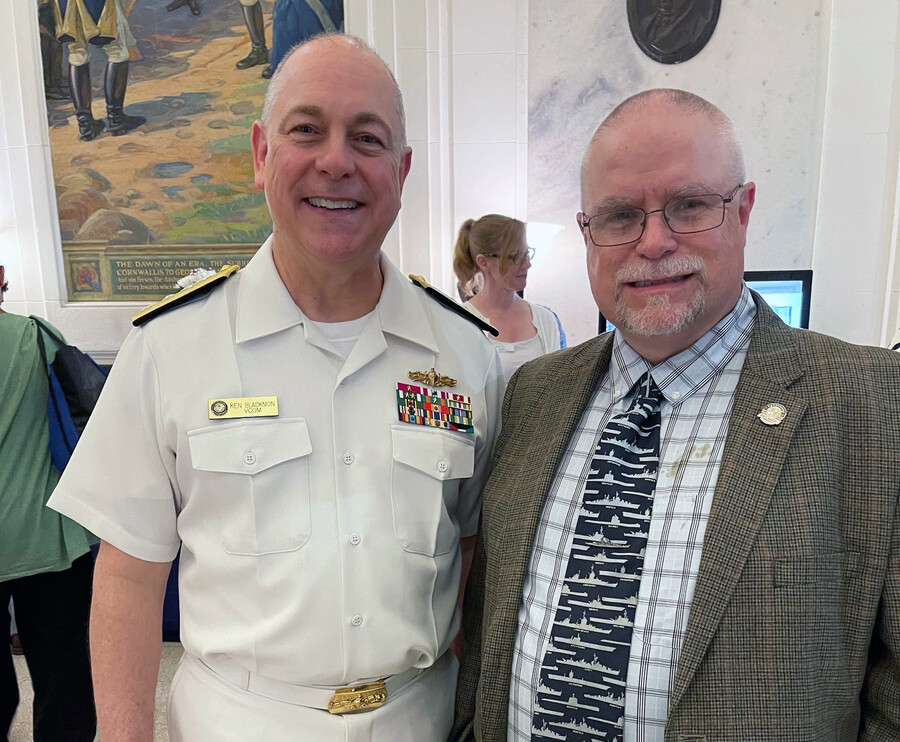Joseph-James “J.J.” Ahern spends his days sorting through remarkable materials: files, folders, and documents in the University Archives and Records Center. As senior archivist, he manages Penn’s historic collections, including processing and appraising notable records and papers.
Away from work, Ahern has applied his expertise as a volunteer, most recently as a guest curator for an exhibition on the history of the U.S. Navy at the Historical Society of Pennsylvania in connection with Homecoming 250, the Navy and Marine Corps’ 250th anniversary. “To Provide a Naval Armament: U.S. Navy & Marine Corps History, 1775 – 1958,” which runs through Jan. 9, offers insight into the lives of those who served in and supported the Navy and Marine Corps through materials in the Society’s collections.
“The Navy is more than just ships and planes,” he says. “It’s the people who build the ships, who maintain the ships, who work on the ships. It’s the average seamen all the way up to admirals.”
Among the items Ahern selected for display are an order for sails from James Forten, a wealthy Black businessman and sailmaker in Philadelphia, found by co-curator Selena Austin; an orders book kept by early American naval figure Stephen Decatur; and a physician’s journal from World War I. It also features the prize money ledger from the USS Alliance dating from the frigate’s service during the American Revolution, under the command of Captain John Barry, which outlines pay for the crew for capturing ships, as well as an 1870s sick call list for ill or injured sailors.
View large image

Rear Admiral Ken Blackmon, U.S. Fleet Forces Command, with Joseph-James “J.J.” Ahern at the opening for an American Swedish Historical Museum exhibit in June 2025. (Image: Courtesy of J.J. Ahern)
“It’s been a fun job,” says Ahern, who went through the Historical Society’s collection seeking documents focused on the stories of regular sailors and workers. “The human side of the story of Philadelphia and the Navy goes all the way back to the beginning,” he says, referencing the date Oct. 13, 1775, when the Continental Congress met in Philadelphia and authorized a fleet that became America’s first Navy.
Ahern attributes his interest in history to “finding the odd connections, the threads that run through history, how when you find one thing it connects to another.” His passion—military and naval history—grew from childhood summers spent with his grandfather in Virginia in the 1980s visiting Civil War battlefields and historic sites, and was further sparked by the 1986 film “Top Gun.” That film, Ahern says, “led to an interest in the Battle of Midway.
“You start learning one thing and it branches out. It goes forward, it goes backwards, and it all gets connected from there,” adds Ahern, who earned bachelor’s and master’s degrees in history from Rutgers University-Camden. He also authored a book on the Philadelphia Navy Yard’s history after discovering records during a post-graduate internship at the National Archives and has written for journals including American Neptune and the International Journal of Naval History. Before coming to Penn in 2006, he worked for the former Atwater Kent Museum and for the American Philosophical Society.
Ahead of the opening of the exhibition at the Historical Society of Pennsylvania, Ahern spoke about Homecoming 250 to a group of staff gathered on campus to discuss America 250 at Penn. That effort is a broad interdisciplinary initiative which brings together colleagues from across the University to recognize the nation’s semiquincentennial through events and programs marking the signing of the Declaration of Independence on July 4, 1776.